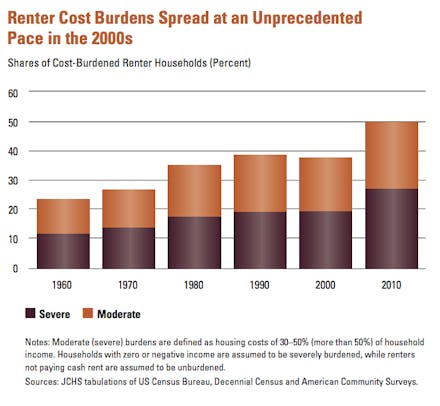Your Rent Really is Too Damn High — Check This Chart

The news: According to a new study from Harvard University’s Joint Center for Housing Studies, increasing numbers of Americans are renting their homes, even though rent is becoming less and less affordable. The study’s results confirm the warnings of karate master, politician, Vietnam veteran, and facial hair virtuoso Jimmy McMillan: The rent really is too damn high.
Source: Joint Center for Housing Studies of Harvard University
The background: The 43 million Americans who rent their homes are paying an increasing share of their income to landlords, as can be seen in the above chart. A majority of renters are now “cost burdened” — i.e., they allocate more than 30% of their income to rent. Worse, over a quarter of Americans are now “severely cost burdened,” spending 50% or more of their income on rent.
Source: Joint Center for Housing Studies of Harvard University
Those numbers have increased sharply since the turn of the century, and are the result of both rising rents, which have climbed 6% since 2000, and of decreasing inflation-adjusted wages, which have dipped sharply since late 2007, and are now 13% lower than they were at the turn of the century.
Source: Joint Center for Housing Studies of Harvard University
The cost burden problem isn’t equally distributed across the United States. As the above map shows, Western states seem to have fared the best, while the Southwest and West Coast have been hit hard by rising rents. While strong employment growth has driven demand, and raised rents, in metropolitan areas like Austin, Texas, and San Jose, Calif., a majority of renters cite the current economic climate as discouraging them from owning a home.
Source: Joint Center for Housing Studies of Harvard University
Despite increasing costs, the number of renters in America is on the rise, as the foreclosures and job losses that accompanied the 2008 financial crisis have pushed more Americans out of home ownership and into the rental market. Despite our modest economic recovery, the study describes the trend as continuing “at a torrid pace — rising at double the rate of recent decades.”
Source: Joint Center for Housing Studies of Harvard University
That demand for housing has far outpaced the availability of affordable units for lower-income families. According to the study, “In 2011, 11.8 million renters with extremely low incomes … competed for just 6.9 million rentals,” 2.6 million of which “were occupied by higher-income households.” It also notes that the availability of affordable units hasn’t increased since the turn of the century, even though the number of low-income renters has gone up by 3 million.
Source: Joint Center for Housing Studies of Harvard University
Even higher-income houses are increasingly burdened, compared to 2001, as can be seen in the above chart. Twice as many households making $45,000 to $75,000 a year are paying more than 30% of their income to rent now, as compared with a decade ago.
The takeaway: There is some good news. Demand for rentals has led to an increase in the construction of multifamily housing units, which should relieve some of the pressure on the current rental market. And hopefully, as the economy recovers, household incomes will once again outpace rent increases. Meanwhile, cities, suburbs, and even rural areas will have to plan for the provision of permanent rental housing stock, and for an increasing number of residents who lack the safety net provided by home ownership.
Source: Joint Center for Housing Studies of Harvard University